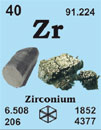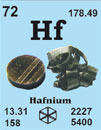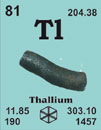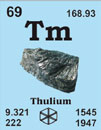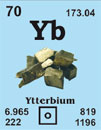Molybdän 42Mo95.94
1781 von P.J. Hjelm in Uppsala, Schweden, dargestellt.
[Griechisch, molybdos = Blei]
French: Molybdène
English: Molybdenum
Italian: Molibdeno
Spanish: Molibdeno
Beschreibung: Das Metall ist glänzend, silberfarbig und in einem reinem Zustand ziemlich weich. Man erhält es gewöhnlich als graues Pulver. Verwendung: Legierungen, Elektroden und Katalysatoren.
Molybdän single crystal properties
| State: |
single crystal |
|---|
| Crystal structure: |
bcc |
|---|
| Production method: |
Floating Zone |
|---|
| Standard size: |
diameter 8-12mm
thickness 1-2mm |
|---|
| Orientation: |
(100), (110) and (111) |
|---|
| Orientation accuracy: |
<2°, <1°, <0.4° or <0.1° |
|---|
| Polishing: |
as cut, one or two sides polished |
|---|
| Roughness of surface: |
<0.03µm |
|---|
| Purity: |
99.99% |
|---|
| Typical analysis (ppm): |
C 3
H < 1
O 9
N < 5
Cu 1.60
Fe 1.80
Ni < 1
Pb 0.30
Si 0.30
Ga, Hf and Ta are below the detection limit
|
|---|
Materials properties
| Density: |
10.2 g/cm3 |
|---|
| Melting point: |
2616.85 °C / 2890 °K |
|---|
| Boiling point: |
4611.85 °C / 4885 °K |
|---|
| Molar volume: |
9.39 cm3 |
|---|
| Thermal conductivity: |
138 [300 K] Wm-1K-1 |
|---|
| Coefficient of linear thermal expansion: |
5.43 x 10-6 K-1 |
|---|
| Electrical resistivity: |
5.2x 10-8 [273 K] Wm |
|---|
| Mass magnetic susceptibility: |
+1.2 x 10-8(s) kg-1m3 |
|---|
| Young's modulus: |
324.8 GPa |
|---|
| Rigidity modulus: |
125.6 GPa |
|---|
| Bulk modulus: |
261.2 GPa |
|---|
| Poisson's ratio: |
0.293 GPa |
|---|
| Radii: |
Mo6+ 62; Mo2+ 92; atomic 136; covalent 129 |
|---|
| Electronegativity: |
2.16 (Pauling); 1.30 (Allred); 3.9 eV (absolute) |
|---|
| Effective nuclear charge: |
3.45 (Slater); 6.98 (Clementi); 9.95 (Froese-Fischer) |
|---|
| Number of Isotopes (incl. nuclear isomers): |
23 |
|---|
| Issotope mass range: |
88 -> 106 |
|---|
| Crystal structure, (cell dimentions / pm), space group |
bcc |
|---|
| X-ray diffraction: mass absorption coefficients: |
CuKα 162 (µ/r) / cm2g-1
MoKα 18.4 (µ/r) / cm2g-1 |
|---|
| Neutron scattering length: |
0.6715 b/10-12 cm |
|---|
| Thermal neutron capture cross-section: |
2.60 sa / barns |
|---|
Biological data
| Biological role: |
essential to all species. |
|---|
| Toxicity |
|
|---|
| Toxic intake: |
n.a. |
|---|
| Lethal intake: |
LD50 (MoO2, subcutaneous, mouse)=318 mg kg-1 |
|---|
| Hazards: |
Animal experiments show molybdenum compunds to be highly toxic and teratogenic, but there is little human data. |
|---|
| Level in humans |
|
|---|
| Blood: |
c. 0.001 mg dm-3 |
|---|
| Bone: |
<0.7 p.p.m. |
|---|
| Liver: |
1.3 - 5.8 p.p.m. |
|---|
| Muscle: |
0.018 p.p.m. |
|---|
| Daily dietary intake: |
0.05 - 0.35 mg |
|---|
| Total mass of element in average [70 kg] person: |
5 mg |
|---|
Geological data
| Mineral | Formula | Density | Hardness | Crystal apperance |
|---|
| Molybdenite |
MoS2 |
4.7 |
1 - 1.5 |
hex. met. grey |
|---|
| Wulfenite |
PbMoO4 |
6.78 |
2.7 - 3 |
tet., res. adam. orange |
|---|
| Chief ore: |
molybdenite; wulfenite to lesser extent; also obtained as by-product of copper production. |
|---|
| World production: |
80 000 tonnes/year |
|---|
| Main mining areas: |
USA, Australia, Italy, Norway, Bolivia |
|---|
| Reserves: |
5 x 106 tonnes |
|---|
| Specimen: |
available as foil, powder rod or wire. Safe. |
|---|
| Abundances |
|
|---|
| Sun: |
145 (relative to H = 1 x 1012) |
|---|
| Earth's crust: |
1.5 p.p.m. |
|---|
| Seawater: |
|
|---|
| Residence time: |
|
|---|
| Classification: |
accumulating |
|---|
| Oxidation state: |
VI |
|---|

 English
English
 Deutsch
Deutsch








































